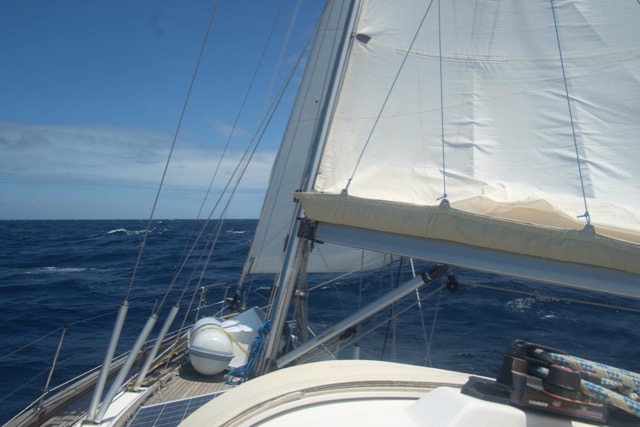Flying Along - 23rd April

Vega
Hugh and Annie
Sun 23 Apr 2017 18:51
04:47.14S 99:05.46W Each evening we try to have supper before it gets dark - leaving just enough time to attend to any deck work before settling down into our watch system. Last night we already had one reef in the mainsail so the only thing left to do was to better secure the cruising chute sailbag onto the foredeck. This completed we then noticed an irritating rattle above the saloon berth where we sleep between watches. Going forward to investigate in the gloom I was startled by a blood curdling scream coming from inside the boat. Fearing something awful I stumbled back to find Annie on her hands and knees, wearing rubber gloves and trying to pick up the flying fish that had flown straight through one of the cabin windows and landed on her foot! Picking it up was tricky given its size - it must have been at least an inch long (at least 3 inches, thank you - Annie).Whether this was an omen or not I don’t know but within an hour or so the wind had started to rise. This was not the normal nighttime pattern but the radar showed no squalls. By 2130 it was blowing around 17kts and I put a second reef in the mainsail. By 2230 it was over 20kts and Annie was up so we put two reefs in the genoa (it has two reefing points) and checked the Grib weather maps (Grib is a type of software for presenting weather data in a visual form). These showed wind of up to 21kts at our latitude and continuing at this latitude until Tuesday, stronger to the south. We therefore changed course to the west for a more comfortable sail and to avoid even stronger wind. Annie stayed on watch and we had wind up to 23kts from the south east and a speed over ground of between 7 and 8kts. It was cloudy overnight and it is much more comforting when sailing under the stars. Nevertheless we had the sailplan we were comfortable with and the direction of travel. As a result we have become separated from Nautilus and there is no longer anyone else showing on AIS or within VHF radio range now. In some ways this is a relief because we no longer feel any pressure to keep up with a faster boat and can now just concentrate on the direction and speed that suits us, even if we take a little longer. Several boats are keeping in touch with a daily noon position and any news or information by email so we are not completely isolated. Furthermore we are flying along at around 7kts. At this rate it will take just under three weeks to reach the Marquesas rather than the four we had anticipated and there is a real sense of excitement about the progress we are making as we reel off the miles. It may be a good thing if we take less time because yesterday the water maker was fired up and gave us 10 litres before making an odd knocking sound and refusing to supply any more water. At this point we were calculating how much water we have on board and how much we might require. We need to drink around two litres each per day so to stay alive we need between 84 and 112 litres. Ideally we will have a flannel wash each day that would be another two litres per day between us or between 42 and 56 litres. Then there is washing up, washing of underwear and various other things but for which the washing water can be recycled. We have tried washing up using seawater and our pans and cutlery started rusting. Some use seawater and a spray of fresh water for rinsing. Presumably you can get detergent that works for underwear in seawater but using seawater would make the garments stiff and feeling damp. So, if needs must, we can just clean ourselves using wipes and hand gel and can accept the rusty Ikea saucepans and even stiff, damp feeling underwear. This means we need something between 112litres (survival) and 250 litres (modicum of comfort). As it happens we have 110litres in water bottles and containers around the boat. We have two water tanks, one is 150litres and remains unused, the other is 250litres and was filled in Santa Cruz which means we drew water from it for a week on Isobela. Unfortunately our water tank gauges only give two accurate readings - full and empty but nothing in between. Possibly we have around 50 litres left in the large tank so that means we know we have around 310litres of fresh water on board so we could survive reasonably comfortably for four weeks; but is that too big a gamble?! My theory concerning the water maker is that after we picked up speed the pump didn’t have enough oomph to overcome the venturi effect from the seawater rushing past the hull intake. It would pump water from an internal source. We shall see……………..  |